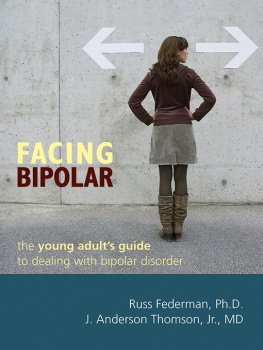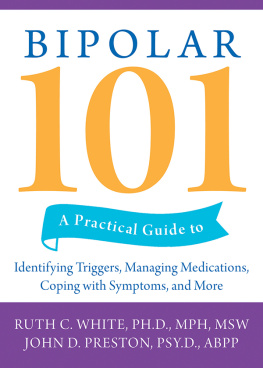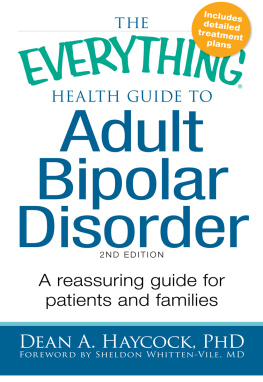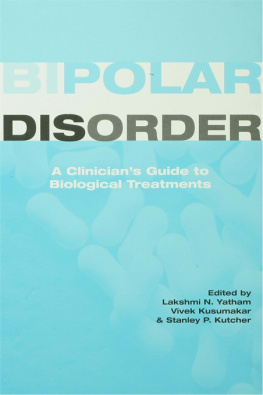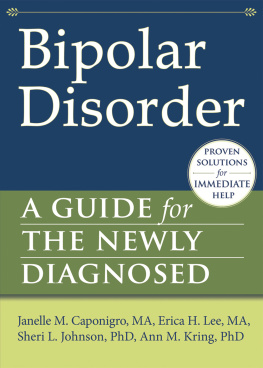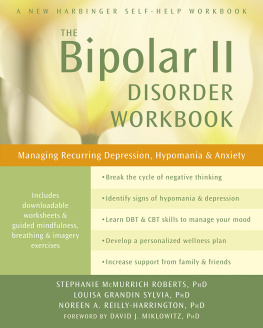Appendix B
using the Sleep, Mood, and Energy Chart
The Sleep, Mood, and Energy Chart is designed to help people with bipolar disorder track trends and changes in three of the key variables that can indicate a significant shift toward either a hypomanic/manic or depressed mood phase.
Sleep: How many hours you slept during the preceding night.
Mood: How you have felt emotionally over the course of your day. Normal means what is generally normal for you when you arent in an elevated or depressed mood state.
Energy: The amount of physical energy that you generally feel over the course of your day. As with mood, normal reflects what is typical for you when your energy isnt elevated or depressed.
Instructions for charting
1. Enter the date range of the week in the top of the chart.
2. Think of your previous night and look for the row that most closely matches the amount of sleep that you had the night before. Place a mark in that row for that day.
3. Preferably around late afternoon or early evening, take a few moments to reflect upon your mood and energy during the course of your day. Even if you've experienced some variability in mood or energy, try to identify an average that reflects your experience of the day, then place a mark in that row for that day.
4. You can place several weeks of charts in a row and staple them together so that you can see a longer progression of your trends. You could even make your own chart on a computer and extend it to cover an entire month or longer.
Sleep, Mood, and Energy Chart

Russ Federman, Ph.D., is director of Counseling and Psychological Services at the University of Virginia and clinical assistant professor in the universitys Department of Psychiatry and Neurobiological Sciences. He is a licensed psychologist, a diplomate in clinical psychology through the American Board of Professional Psychology, and a member of the editorial board for the Journal of College Counseling.
J. Anderson Thomson, Jr., MD, is a staff psychiatrist at the University of Virginias Counseling and Psychological Services in the Department of Student Health. He is a clinical assistant professor in the universitys Department of Psychiatry and Neurobiological Sciences. He is also a staff psychiatrist at the University of Virginia's Institute of Law, Psychiatry, and Public Policy and at Region 10 Community Services. He maintains a private practice in Charlottesville, VA.

Chapter One
what is bipolar disorder and how can you tell if you have it?
Bipolar disorder is a mood disorder. So what is mood? Mood is like the color in a painting or the tone and intensity of a piece of music. It reflects our emotions and thoughts, whether we feel anxious or relaxed, happy or sad, or anything in between. Mood isnt a reflection of any one thing; its a combination of many. Just think of all the parts of your experience that lead to the expression Im in such a good mood or, conversely, Im feeling really down.
So whats normal mood? Usually, throughout your day you have a variety of experiences that cause subtleor even not-so-subtleshifts in your mood. Thats quite normal. Life without mood changes would be flat. Its the variability of your mood that gives your life texture and dimension. When your mood changes, its usually because of how you feel about something thats happening in the world. Normal mood states dont change significantly without a clear cause-and-effect explanation. When good stuff happens, you generally feel good. Similarly, a day of frustration and disappointment can bring you down.
Just as the type of mood you experience varies, so does the intensity of your mood. Lets say youre in school and youre generally doing well but you fail a quiz. This is going to feel very different than if you just learned you failed out of school. The first situation will feel bad, while the second will probably feel awfuland for much longer. Again, strong mood changes usually make sense when they have a connection with whats happening in your life. When they dont and you keep having them, then things begin to feel screwy.
And sometimes things feel screwy if you have bipolar disorder. In fact, with bipolar, mood states can become way out of balance, because mood changes can occur independently of whats going on in life. If youre bipolar, you may also have thoughts and feelings that get more and more intense until you feel out of control. And whats worse, this increasing intensity can seem to come out of nowhere. Nothing caused it, that you can see, but like it or not you find that youre no longer in the drivers seat. Those intense shifts in mood, for no reason, are the roller-coaster reality of bipolar disorder. This isnt normal mood, and yes, it can be downright frightening.
You may also be frightened because of where you are in your life. For those who dont develop bipolar disorder when theyre kids, the first explicit symptoms often appear between late adolescence (approximately sixteen or seventeen) through the mid-twenties. If youre in that age range, particularly at the younger end, then life isnt all that stable or well established. In fact, you may be in the midst of many changes all at the same time, such as dealing with the craziness of high school, preparing for college, living away from home for the first time, starting your first job, or heading off to graduate school or beyond. With all the big changes youre facing at this stage of your life, the last thing you need is the additional complexity of a major mental disorder. Add the bipolar dimension to the mix, and youve got quite a handful.

